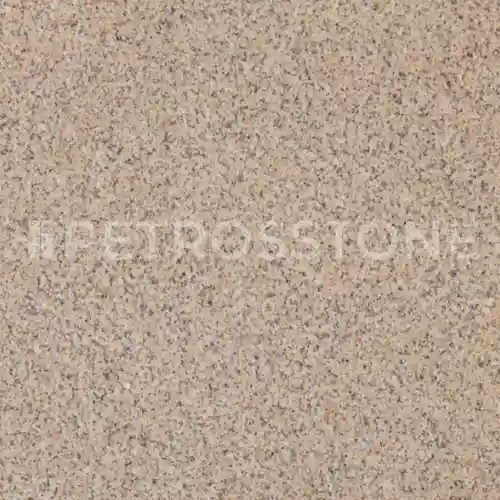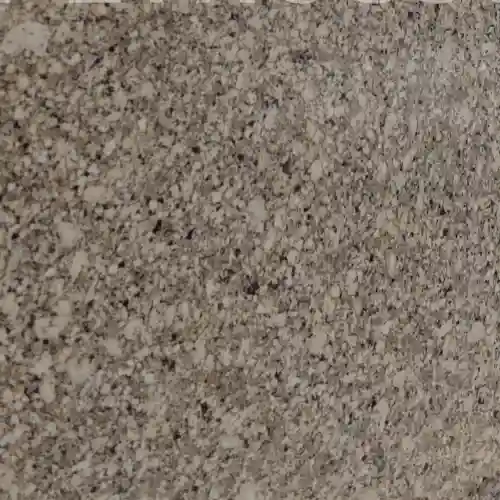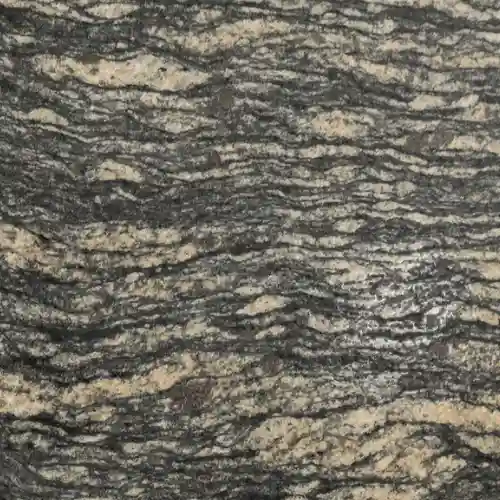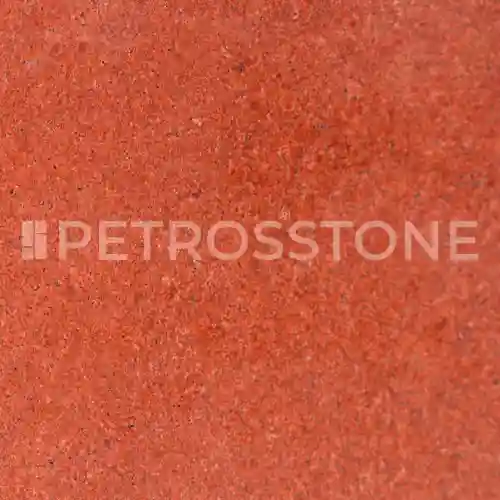
This guide will compare four common natural stones – flagstone, slate, sandstone, and limestone. Their properties are explained to clarify which material is best for each application.
Not all stones are alike. You wouldn’t use the same rock for a mountain trail as you would for a polished floor. And so why play guesswork when selecting materials for your home or landscape?
You may be laying down a patio that withstands years of foot traffic, a driveway that won’t crack under car weight and pressure, or an interior floor that reflects elegance – choosing the right natural stone is important.

- Quick Comparison: Flagstone vs. Slate vs. Sandstone vs. Limestone
- Getting to Know the Stones – What Makes Them Different?
- How Tough Are They? Durability and Weathering
- Hydrogen, Water, Stains, and Upkeep.
- Flagstone
- Slate
- Sandstone
- Limestone
- Best Use: Outdoor vs. Indoor
- Cost Analysis
- Conclusion – Making the Right Choice
Quick Comparison: Flagstone vs. Slate vs. Sandstone vs. Limestone
Let’s summarize the key differences in a table:
| Feature | Flagstone | Slate | Sandstone | Limestone |
| Durability | Varies (Good if Hard Type) | Very High | Varies (Moderate to Good) | Lower |
| Weather Resist. | Varies (Good if Hard Type) | Very High | Varies (Moderate) | Lower |
| Water Absorption | Varies | Very Low | Moderate to High | Very High |
| Maintenance | Moderate (Sealing often helps) | Low | Moderate to High (Sealing needed) | High (Regular sealing, gentle clean) |
| Cost | Varies (Moderate to High) | High | Moderate | Moderate to High |
| Look & Feel | Rustic, Natural, Varied | Elegant, Smooth, Refined | Warm, Earthy, Granular | Classic, Elegant, Soft |
| Best Outdoor Use | Patios, Paths, Steps | Roofing, Patios, Paths, Pool Decks | Patios, Paths (Mild Climates) | Very Limited (Dry, Mild Climates Only) |
| Best Indoor Use | Rustic Floors, Walls | Floors, Walls | Floors (Low Traffic), Walls | Floors (Low Traffic), Walls, Decor |
| High Traffic? | Okay (Durable types) | Best Choice | Less Ideal | Not Recommended |
| Workability | Fitting irregular shapes takes time | Needs skill (esp. roofing) | Relatively Easy to Cut/Shape | Easiest to Carve |
Getting to Know the Stones – What Makes Them Different?
All four are natural, but they differ in origin and formation.
- Flagstone: This one is defined more by shape than by material. Flagstones are flat, irregularly shaped slabs used for patios and paths. Usually they’re sedimentary rocks like sandstone or metamorphic rocks like slate or quartzite that split in layers. Flagstone comes in many colors and textures and is usually rustic or natural-looking.
- Slate: Made from shale or mudstone heated and compressed underground (metamorphic rock), slate has a fine grain. It has a characteristic of splitting into thin, smooth, flat sheets. You may notice layers or textures beneath the surface. Slate is usually darker in tone – grays, blacks, greens, and purples – and very elegant.
- Sandstone: It is made of grains of sand cemented together over millions of years (sedimentary rock). The sand is often felt and seen. They come in warm earthy colors like beige, tan, pink, red, and brown – often with swirling patterns or bands from their formation.
- Limestone:It’s another sedimentary rock made mainly of calcium carbonate – sometimes from the compressed shells and skeletons of ancient sea creatures. Sometimes you can find little fossil pieces! It’s generally softer than the others and comes in light, creamy colors like white, beige, tan and light gray and has a classic, formal look.
How Tough Are They? Durability and Weathering

This is important, especially for outdoors.
- Flagstone: varies in toughness depending on the rock. Quartzite flagstone? Very tough. Softer sandstone flagstone? Less so. Thicker pieces are generally stronger. Harder types tolerate weather well.
- Slate: For durability, Slate is a champ. This stuff is tough and dense and will withstand freezing temperatures and general wear and tear well. It does not absorb water easily so it lasts longer outdoors.
- Sandstone: Durability varies depending on the sandstone type. Some sandstone is very hard and resistant. Some are softer and porous – like a sponge. Porous sandstone absorbs water and is susceptible to staining, moss, and cracking if water freezes inside during winter.
- Limestone: The softest and most fragile of the groups. It is more porous and will wear down from heavy foot traffic, will scratch more easily, and will be damaged by acid rain or freeze-thaw cycles. It performs best indoors or in very mild, dry climates.
Hydrogen, Water, Stains, and Upkeep.
How much water a stone absorbs influences how easily it stains and how much maintenance you’ll need to do.
- Flagstone: Porosity varies. Some dense varieties resist water very well; others soak it up more. Sealing is recommended for flagstone patios or walkways to prevent staining and water issues. A basic clean includes sweeping and washing.
- Slate: Naturally, Slate is very impervious. This helps with water and stain resistance. It usually requires minimal upkeep – just a little cleaning. Not usually necessary but sometimes done to enhance color.
- Sandstone: It is porous. You can expect it to soak up spills or rainwater, making it more susceptible to staining, algae/moss growth in damp areas, and possible frost damage. Sandstone should be sealed regularly, especially outdoors. They might need more frequent cleaning too.
- Limestone: The most porous is limestone – it’s like a sponge. The fabric stains easily (watch out for wine, oil or wet leaves!) and absorbs water easily. Limestone needs sealing and maintenance. Spills need immediate attention – use pH neutral cleaners – anything acidic (vinegar, lemon juice, harsh chemicals) will etch and scratch the surface.

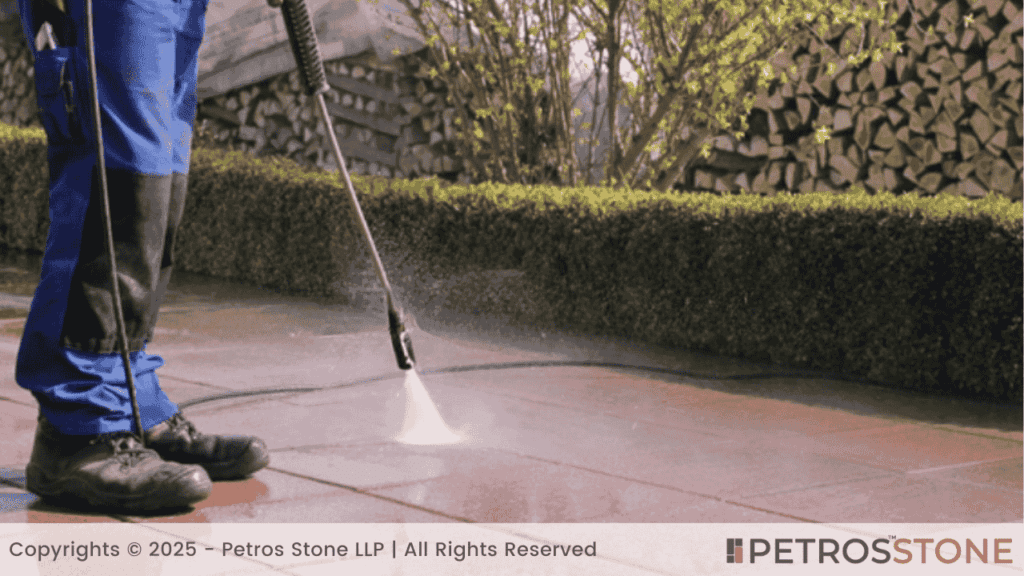
Flagstone

Known for its flat, often irregular pieces, flagstone brings a natural, organic feel. Its variety in rock type means lots of color and texture options.
Pros & Cons of Flagstone
Why Choose It?
- Natural Beauty: Great for blending paths and patios into landscapes.
- Unique Look: Irregular shapes mean no two projects are exactly alike.
- Good Durability (Select Types): Harder varieties like quartzite are very long-lasting.
- Slip Resistant: The textured surface usually offers good grip.
Things to Consider:
- Installation Effort: Fitting irregular pieces takes more time and skill.
- Variable Needs: Some types need sealing more than others.
- Surface Unevenness: Might not be ideal for patio furniture with thin legs.
- Cost Range: Price varies a lot based on the stone type.
Applications
- Patios and garden walkways (its most common use).
- Pool decks (good texture for grip).
- Stepping stones across lawns or gardens.
- As a veneer for walls for a rustic look.
Slate
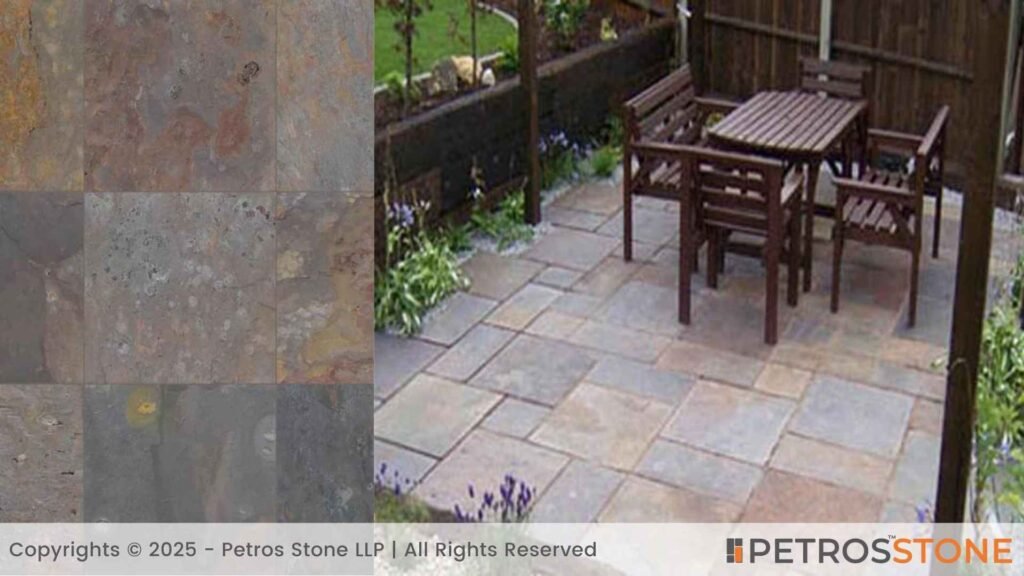
Recognized by its fine grain and ability to split into smooth, thin layers, slate offers a sleek, sophisticated appearance.
Pros & Cons of Slate
Why Choose It?
- Super tough – Resists weather, water, scratches and stains. Lasts ages.
- Easy to clean & usually does not need sealing.
- Elevated Appearance: Looks refined and high-end.
- Many applications work indoors or outside.
Things to Consider:
- Higher Price Tag: Often one of the more expensive options.
- Subdued Colors: The color palette is typically darker and less varied than sandstone.
- Slippery When Polished: Stick to the natural cleft finish for outdoor grip; polished slate can be slick when wet.
- Installation Skill: Proper installation, especially for roofing, needs expertise.
Applications
- Roofing (the classic, long-lasting slate roof).
- Flooring (kitchens, bathrooms, entryways, patios – very durable).
- Wall cladding (adds a modern, protective layer).
- Pool surrounds and paving.
- Stylish garden features like benches or water walls.
Sandstone
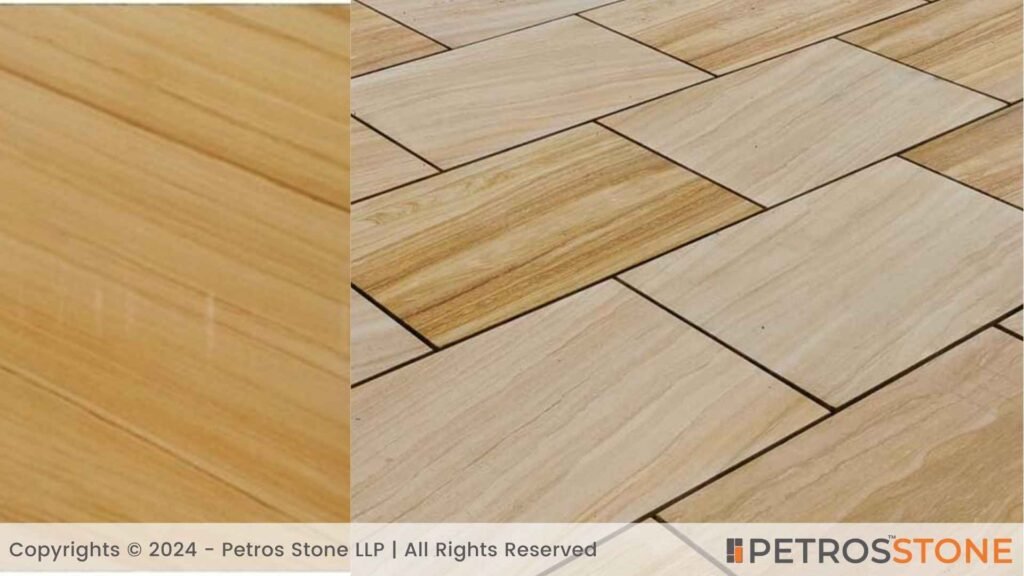
With its visible sandy texture and warm, earthy colors, sandstone brings a welcoming, natural feel. Often shows beautiful layers or patterns.
Pros & Cons of Sandstone
Why Choose It?
- Color Variety: Comes in a wide range of appealing, natural tones.
- Often Budget-Friendly: Can be more affordable than slate or limestone.
- Easier to Work: Generally softer, making it easier to cut or shape.
- Warm Aesthetic: Creates a cozy, inviting atmosphere.
Things to Consider:
- Absorbs Water: Its porosity makes it prone to staining and potential weather damage if not sealed.
- Less Tough Than Slate: Not as resistant to heavy wear or harsh conditions.
- Needs Sealing: Regular sealing is usually a must, especially outdoors.
- Environmental Sensitivity: Some types can be affected by pollution or acid rain over time.
Applications :
- Patios and walkways (great in milder climates, keep it sealed).
- Wall cladding (adds warmth and texture).
- Garden walls, benches, planters.
- Interior flooring (best for areas without constant heavy traffic, needs sealing).
- Decorative accents and carvings.
Limestone

Known for its soft, creamy colors and often smooth texture, limestone offers a classic, often formal elegance.
Pros & Cons of Limestone
Why Choose It?
- Timeless Beauty: Looks elegant and sophisticated, often used in traditional designs.
- Light, Bright Colors: Creates a bright, airy feel.
- Good for Carving: Relatively easy to shape for detailed work.
- Stays Cooler: Doesn’t absorb as much heat from the sun as darker stones.
Things to Consider:
- Very Porous: Stains very easily and absorbs water readily. Highest maintenance needs.
- Softer/Less Durable: Scratches and wears more easily than the others. Not ideal for high-traffic or harsh outdoor areas.
- High Maintenance: Requires frequent sealing and only gentle, pH-neutral cleaners. Acid sensitivity is a major issue.
- Acid Damage: Easily etched by acidic substances (even rain, wine, fruit juice).
Applications :
- Interior Flooring: Beautiful for formal living areas, bedrooms (low-to-moderate traffic). Sealing and careful cleaning are essential.
- Interior Wall Cladding: Adds a touch of classic luxury.
- Decorative Features: Ideal for fireplace surrounds, mantels, carved details where durability isn’t the top priority.
- Outdoor Use (Very Limited): Only consider for patios/walkways in very dry, mild climates with rigorous sealing and maintenance. Generally not the best outdoor choice. Formal garden elements in protected spots.
Best Use: Outdoor vs. Indoor
- Outdoors: Slate is often the top performer due to its durability and low water absorption. Harder types of Flagstone are also excellent. Sandstone can work if you’re careful about sealing and climate. Limestone is generally the riskiest choice for outdoors unless conditions are perfect and maintenance is high.
- Indoors: All can be used effectively. Slate is durable and sleek. Limestone offers classic elegance but needs care in high-traffic spots. Sandstone provides warmth. Flagstone gives a unique rustic touch. Choose based on the room’s use and your desired style.
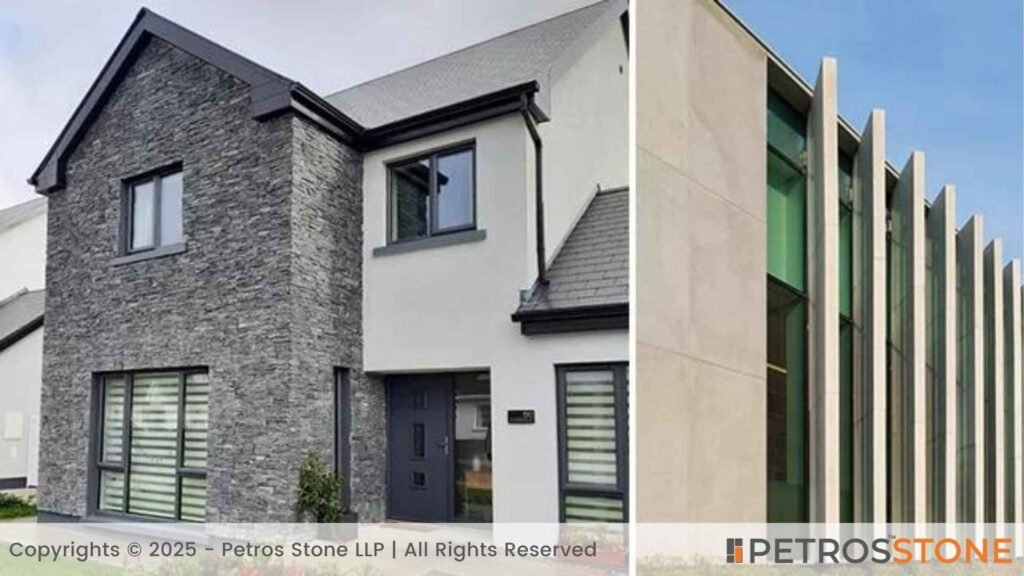
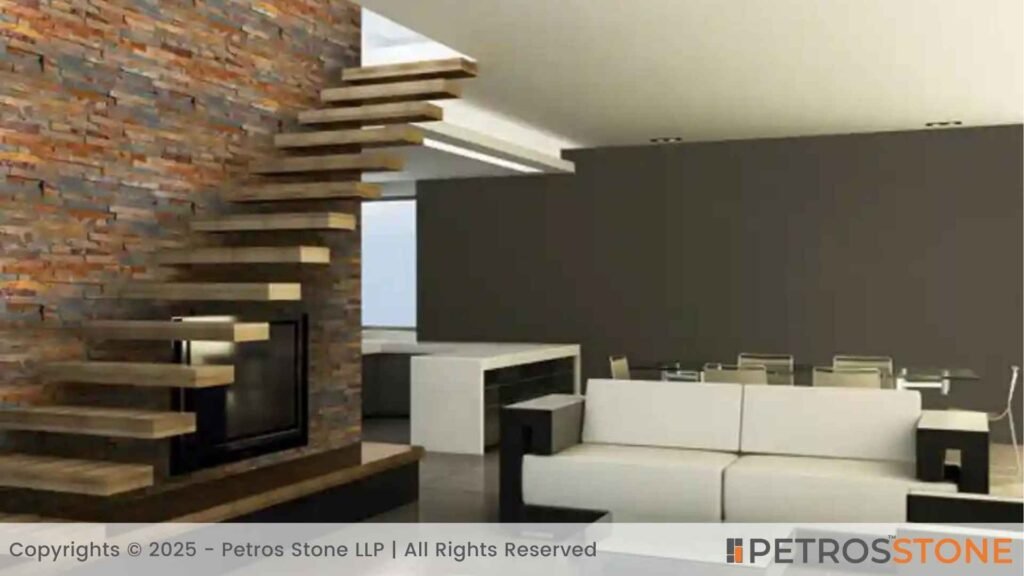
Cost Analysis
| Sr. | Name | Image | Size | Finish | Price |
| 1 | Flagstone | 36” x 4” x ⅜”36” x 6” x ⅜”And more | Natural, Rough, Honed | Chat with us | |
| 2 | Slate | 36” x 4” x ⅜”36” x 6” x ⅜”And more | Natural Cleft, Polished | Chat with us | |
| 3 | Sandstone | 36” x 4” x ⅜”36” x 6” x ⅜”And more | Honed, Sandblasted | Chat with us | |
| 4 | Limestone | 36” x 4” x ⅜”36” x 6” x ⅜”And more | Polished, Brushed | Chat with us |
Conclusion – Making the Right Choice
So, which stone should you pick? There’s no single right answer – it truly depends on your project. Ask yourself:
- What look am I going for? (Rustic? Modern? Classic? Warm?)
- Where will it be used? (Indoors? Outdoors? High traffic? Poolside?)
- What’s my climate like? (Lots of rain? Freezing winters?)
- What’s my budget?
- How much maintenance am I willing to do?
By thinking through these questions and considering the pros and cons of flagstone, slate, sandstone, and limestone we’ve covered here, you’ll be much better equipped to choose the natural stone that will not only look great but also perform well for years to come.
Still unsure? The team at Petrosstone has years of experience working with all these premium natural stones. So whatever your needs are – busy commercial space, stylish home interior or tough outdoor area – we can help you choose the right solution.
See our selection & get advice for your next project.
Feel free to get in touch for a free consultation, quote, and get a detailed understanding from our experts here at Petros®. Visit https://petrosstone.com/ or call +91-8446360361 and WhatsApp

Hi, I’m Dhananjay,
With a background in architecture and years of industry experience, I share insights on materials that shape great design. At Petros® Stone, I craft content that highlights the beauty and utility of natural stone, helping architects, builders, and homeowners make informed choices while strengthening the brand’s voice and online presence.
Cot Ca Gold Granite
Black Wave Polished Granite
China White Granite | Price, Manufacturer | All Info
Pearl White Granite
Marquina Leather Granite
Red Lakha Granite

